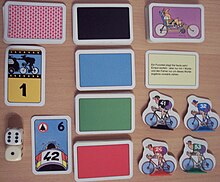To tire width
| To tire width | |
|---|---|
| Game data | |
| author | Rob Bontenbal |
| publishing company |
Homas Spelen (1979), Jumbo (1991/92, 2002) |
| Publishing year | 1979, 1991/92, 2002 |
| Art | Board game |
| Teammates | 2 to 4 |
| Duration | 90 minutes |
| Age | from 8 years
|
| Awards | |
|
Game of the Year 1992 |
|
Um Reifenbreite is a board game for 2 to 4 players by the Dutch author Rob Bontenbal , which was published in 1991/92 by Jumbo , a brand of the Dutch game publisher Hausemann & Hotte, and won the 1992 Game of the Year award. The game was reissued in 2002 for the tenth anniversary of Jumbo . Here, the players slip into the role of the team manager of a cycling team, which fights for the yellow jersey through targeted use of resources and with a little luck.
In some countries it was called Demarrage! (France, UK) or Demarraje (Spain); in Italy it was sold as Campionato Italiano .
The game is almost identical to the game Homas Tour by the same author , published in 1979 by Homas Spelen in the Netherlands . The structure of the game board is identical, the rules are similar.
content
- 1 game board
- 20 drivers (4 teams of 4 drivers each plus one driver in a yellow jersey per team)
- 56 energy cards (14 per team, 4 for driver 1, 2 each for driver 2 - 4, 4 jokers)
- 22 opportunity cards
- 6 photo cards
- 2 dice
- 1 scoring block
- Instructions for use (16 A4 pages)
Style of play
The game can be played in three variants. In the simplest version, a route is selected on the game board and the road surface is not taken into account; in an extended version, the road surface (cobblestones or mountain routes with ascent and descent) has an influence on the course of the race, just like in a real bike race. For experienced players, several routes can be combined into a stage race in the professional version, in which sprint ratings and the fight for the yellow jersey are added.
In general, a race begins with the players, as team leaders, placing their drivers on the starting fields one after the other, with one driver from each team having to stand in each of the 4 starting lanes. The race or in each lap starts the driver who is furthest ahead and to the right in the direction of travel. The player rolls both dice and moves the driver forward by the number of both dice. Now all drivers who were previously behind him are allowed to follow in the slipstream if they then land directly behind the man in front and do not cover more fields than him. Of course, you only do this when the person in front has covered a long distance, otherwise you trust your luck with the dice. Then the other drivers are moved.
In the next round, one or both dice can be replaced by energy cards that can be used to move 5 or 6 spaces. However, some cards may not be used on all types of roads. Used cards come out of the game, so you have to handle them carefully.
If a player rolls a 7, he must take an opportunity card. This can lead to falls, which can also affect the following and neighboring drivers, but sometimes energy cards are returned.
For drivers who cross the finish line, points are determined with the help of the scoring sheet, which are then added up for the teams. The winner is the team with the most points. If several stages are driven, for which there are four suggestions in the rulebook, each stage is scored for itself. However, the results of the best driver are multiplied by the number of stages and added to the team result. This takes into account the usual behavior in large stage races such as the Tour de France that every team tries to support its captain.
Specialty
In 2002, for the tenth anniversary of its existence, a new edition appeared in a more compact packaging, in which the game plan no longer had three kinks, but was divided into six segments. The instructions have been reduced to 12 pages using a smaller font. In addition, two additional fields have been added to a curve on the 2nd outer lane.
Use at championships
For tire width was played in the regional preliminary decisions for the German team championship in 1994.
Web links
- To tire width at game of the year
- To tire width in the games database Luding
- To get tire width in the board game database BoardGameGeek (English)
- PC version
Individual evidence
- ↑ To tire width at cyclingboardgames.net (English)
- ↑ Bike racing games ( Memento of the original from April 28, 2009 in the Internet Archive ) Info: The archive link was inserted automatically and has not yet been checked. Please check the original and archive link according to the instructions and then remove this notice. at the European Game Collectors Guild
- ↑ Homas Tour at cyclingboardgames.net (English)
- ↑ compare game board Um tire width and Homas Tour
- ↑ Comparison of rules at gamecabinet.com (English)

